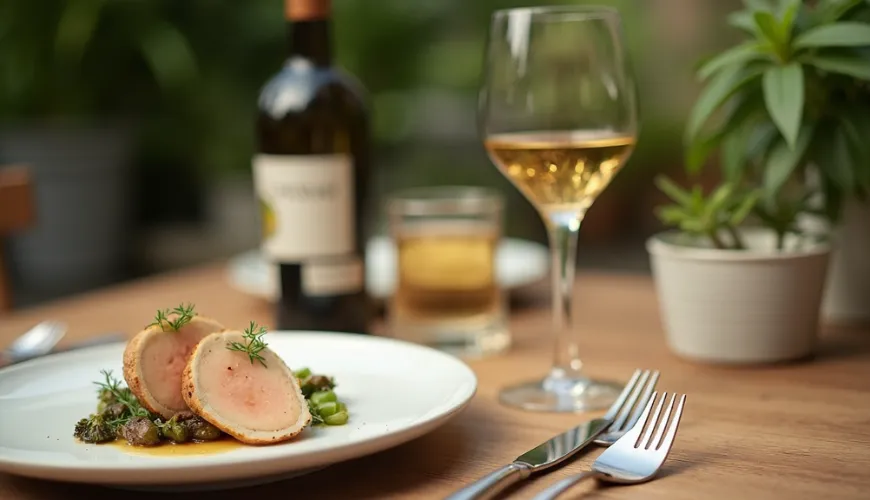
Foie Gras in Modern Gastronomy: Ethical Alternatives and Innovations

Foie gras. Two words that evoke emotions in gastronomy – from fascination to controversy. For gourmets, it embodies luxury, while for others, it symbolizes an unethical approach to animal farming. Regardless of which group you belong to, it's undeniable that this is one of the most distinctive delicacies in world cuisine. But what exactly is foie gras? How is it prepared, and why does it cause such a stir? And are you familiar with the traditional foie gras torchon? This article delves into the history, taste, and ethics of this exceptional dish and offers insights into its home preparation.
Foie gras - what is it and where does it come from?
The French term foie gras literally means "fat liver." It refers to duck or goose liver that has been specially fattened to develop fatty infiltration – a process known as steatosis. The result is tender, buttery smooth liver with a distinctive taste that melts in your mouth. In gastronomy, it's an ingredient of exceptional value, used in appetizers, pâtés, or hot dishes.
The origins of foie gras date back to ancient Egypt, where people observed that wild geese naturally stored fat, especially in their livers, before migration. The Egyptians began feeding these birds grain to achieve the same effect, and the basic principle of foie gras production was born. From there, the technique spread through the Greeks and Romans to France, where foie gras became an integral part of culinary culture, particularly in the regions of Alsace, Périgord, and Gascony.
Today, foie gras is protected by the status of "cultural and gastronomic heritage of France" and is considered one of the pinnacles of French cuisine. However, its production is banned in some countries due to the feeding method, which many consider unethical.
Ethics and controversy surrounding foie gras
The main point of criticism of foie gras is the feeding method, known by the French term gavage. Birds, usually mulard ducks, are fed a high-calorie corn mixture several times a day using a metal tube inserted directly into the esophagus during the last two to three weeks of their lives. Although effective, this process is often labeled as inhumane.
Organizations like PETA or Compassion in World Farming have long pointed out the suffering of animals in foie gras production. As a result, many countries – including the United Kingdom, Germany, Israel, or California – have banned the production of foie gras, although its consumption remains legal. In the Czech Republic, production is allowed but limited in scope. Most foie gras on our market comes from France or Hungary, where production is still widespread.
Interestingly, some farms are attempting alternative ethical feeding methods that utilize the birds' natural behavior, such as seasonal overeating before migration. These efforts are still in their infancy but represent an intriguing direction for development.
Taste and use in the kitchen
Despite all the controversy, foie gras remains one of the most prized culinary experiences. Its taste is delicate, buttery, slightly sweet, with a dense texture that literally melts in the mouth. Foie gras is most often served as a cold appetizer, for example, in the form of pâté, terrine, or the torchon.
The foie gras torchon is a classic and highly valued form that allows the full flavor and texture of the liver to shine. The word torchon means towel in French, referring to the preparation method – the liver is wrapped in cloth, shaped into a roll, and slowly cooked at a low temperature. The result is a luxurious delicacy served sliced with a piece of toasted bread and a sweet wine or fruit reduction.
Foie gras pairs excellently with wines with residual sugar, such as Sauternes or Tokaj. Their sweetness beautifully contrasts with the pronounced liver flavor, creating a harmony considered one of gastronomic perfections.
Foie gras recipe - homemade torchon
Although it may seem that foie gras torchon is solely the domain of Michelin-starred restaurants, it can be prepared at home. It requires a bit of patience and meticulousness, but the result is worth it. Here is a simple and proven recipe:
Foie Gras Torchon - Homemade Recipe
Ingredients:
- 1 whole foie gras (approx. 400–500 g), ideally fresh or high-quality frozen
- 10 g salt
- 2 g freshly ground white pepper
- 1 tablespoon of port wine or cognac
- gauze or cloth, plastic wrap
- Let the liver soften at room temperature, then carefully divide it into two parts and remove visible veins.
- Season with salt, pepper, and drizzle with alcohol. Let marinate for several hours, ideally overnight.
- Form the liver into a roll, tightly wrap in gauze or cloth (torchon), and wrap several times with plastic wrap. Tie the ends like a candy.
- Place in warm water (approx. 60°C) and gently poach for 10–15 minutes.
- Immediately chill in ice water and refrigerate for at least 2 days.
Serve the resulting torchon sliced with homemade bread, fig jam, or onion confit.
Foie gras in modern times
While foie gras remains a symbol of traditional French cuisine, the world is changing. There is a growing demand for ethically produced food, and even in the world of luxury ingredients, there is pressure for transparency, sustainability, and consideration. Some top restaurants, including those with Michelin stars, have completely abandoned foie gras. Others are trying to find a reasonable balance, perhaps through innovative farming.
In 2022, for example, a Spanish farm in the Extremadura region presented foie gras made from geese that were fed naturally, without a tube – only with seasonal fruit and grain. The result was liver with a pronounced flavor and without a shadow of controversy. Such examples show that the future of luxury does not have to be at odds with ethics.
One culinary legend, Alain Ducasse, once said: "The real luxury of today is quality that is not at the expense of someone else." These words are gaining new meaning today – not just in relation to foie gras, but in gastronomy as a whole.
In the Czech context, foie gras remains more of a specialty for special occasions. But with the growing interest in quality ingredients, culinary experiences, and home cooking, there are also people here who decide to try what it really means to prepare a foie gras torchon – whether out of pure gourmet curiosity or as part of a deeper interest in traditional cuisine.
And perhaps that's where its charm lies: foie gras is a truly exceptional dish that simultaneously raises deeper questions about what it means to eat well – and with respect.

